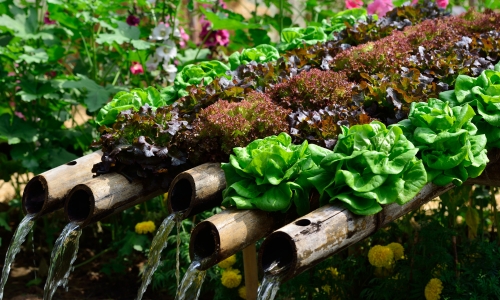Hydroponics- a novel method of agriculture
INTRODUCTION
- Hydroponics is a technique of growing plants in nutrient solutions with or without the use of an inert medium such as gravel, vermiculite, rock wool, peat moss, saw dust, coir dust or coconut fibre to provide mechanical support.
- The Greek terms “hydro” (meaning water) and “ponos” (meaning labour) are the source of the word “hydroponics,” which literally means “water work.”
- Due to rapid urbanisation and industrialisation, not only is the cultivable land decreasing, but also conventional agricultural practices are causing a wide range of negative impacts on the environment.
- Innovative methods to cultivate sufficient food have to evolve to feed the world’s growing population in a sustainable manner. Modification in growth medium is an alternative for sustainable production and to conserve fast-depleting land and available water resources.
- In the present scenario, soilless cultivation might be commenced successfully and considered as an alternative option for growing healthy food plants, crops or vegetables.

Figure 1: Hydroponics farm
Types of hydroponics:
- Nutrient Film Technique- A thin film of nutrient-rich water feeds plants, supporting optimal growth in a water-efficient system.
- Deep water culture – Plants are suspended in containers containing nutrient-rich water solution, which promotes healthy root development.
- Wick system – Wick hydroponics is a simple and efficient method of delivering nutrients to plant roots, fostering consistent growth.
- Ebb & Flow system- This hydroponic system switches between flooding and draining to provide plants with optimal nutrient uptake and oxygenation.
- Drip system-Precise nutrient delivery via drip system promotes healthy plant growth while minimising water usage and increasing efficiency[1].
Advantages
- Hydroponic farming can be used in areas like arid deserts or cold climates where it is not feasible to cultivate or cultivate in the ground.
- Greater control over pH, growth conditions, and nutrient content.
- Reduced expenses for water and nutrients when recycling water and nutrients.
- Quicker growth because the root region has more accessible oxygen.
- Reduction or eradication of bacteria, fungi, and insects associated with soil.
- Increased crop production.
- No cultivation or weeding is necessary.
- Crops like strawberries and lettuce can be raised higher above the ground for planting, tending, and harvesting. This reduces labour costs by providing far better working conditions.
- Fallowing or crop rotation is not required.
Disadvantages
- Compared to soil cultivation, there are greater upfront and ongoing costs.
- More technique-sensitive than traditional soil cultivation.
- Certain illnesses, such as Verticillium and Fusarium, can spread swiftly throughout the plant body.
Future Scope of Hydroponics:
- Hydroponic methods for cultivating rice have been tried in Japan. Rice is cultivated in subterranean chambers without soil. Since the environment is meticulously controlled, four harvest cycles are achievable annually compared to conventional single harvest practice.
- Hydroponics are also successful in Israel, a country with a dry and arid climate. Berries, bananas and citrus fruits, which could not be grown in Israel’s climate, could be cultivated using hydroponics. Moreover, the technique could yield 1,000 times more than that of land.
- Hydroponics has important implications for the future of space travel. NASA has extensive plans for hydroponics, which will benefit both present space missions and the prospect of long-term living on Mars or the Moon [2].





